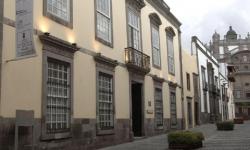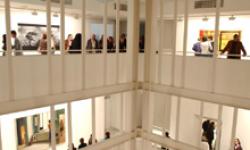The Centro Atlantico de Arte Moderno, which reports to the Cabildo [government] of Las Palmas de Gran Canaria. Spain, was opened on 4th December, 1989. In its initial expression of aims the new cultural institution proclaimed its intention to operate as an Arts Centre --a place for engaging in diverse activities and discussions involving the arts-- and also as a Contemporary Art Museum, which would become a regional reference point by building a permanent collection of art works.
The concept of tri-continentality, as a space of convergence for the cultures of Europe, Africa, and America, is the guiding principle underlying the overall projects of the CAAM as an Arts Centre, as is the art collection. As well, the analysis of modernity and the emerging processes of contemporary culture complete the expositions.
To these ends today’s Centro Atlantico de Arte Moderno was built at no. 11, Los Balcones, in the historic Vegueta neighbourhood, in an old building with an original façade from the 18th century that must be conserved. The Museum was designed by the architect Francisco Javier Sáenz de Oiza, according to the following:
• 4 floors of exhibitions
• Central-library of reference
• Offices and studies
• Warehouse for works of art
• Shop
• Service area and other necessary accessories.
In 2002 the Museum’s exhibition rooms were extended after the acquisition of the adjacent house, no.13, Los Balcones.
Nowadays, the offices are situated at no. 9, Los Balcones. On this building’s ground floor, the exhibition rooms have throughout the history of the Museum been the scene of numerous architectural displays, as well as being the main place for educational workshops which develop alongside every exhibition.
The CAAM arranges a lot of projects in the Sala San Antonio Abad. In this room they have had successive exhibitions that reflect contemporary practice.
The collection of the Centro Atlantico de Arte Moderno is a result of more than fifty years of public collecting in the Canaries. This collection joins together a significant part of art collection from the 20th century that the Cabildo of Las Palmas de Gran Canaria. Spain possesses with pieces from Canarian artists, together with works from other artists from the 30s and 40s, and from the group El Paso in the 80s and 90s.
Exhibitions held by the Museum in the 1990s, all reflected the CAAM’s founding notion of tri-continentality. They opened the Museum’s collections of art created in Africa and Latin-America. At the same time acquisitions were made of periods and authors not sufficiently represented in the Museum like Spanish and International art from the eighties till today.
Over these past years the CAAM has been prolific in staging exhibitions, with more than a hundred to its credit so far. Noteworthy among these were such projects as El Surrealismo entre Viejo y Nuevo Mundo; Artistas Rusos Contemporáneos; Hacia el Paisaje; Desplazamientos; Africa Hoy; El Museo Imaginado; Automatismos Paralelos; Historia Natural. El Doble Hermético; Voces de Ultramar; Millares; La Vanguardia Rusa; Los Géneros de la Pintura; Otro País. Escalas africanas; Miguel Martín; Herejías; Expresionismo Alemán; Óscar Domínguez; Cuba Siglo XX; Gaceta de Arte; De Juan Hidalgo; Islas; Trasatlántico; Juan Ismael; Forjar el Espacio; A Rebours; Convergencias/Divergencias; Aires: Luces y sombras en Las Palmas de Gran Canaria; Máquinas; El Arte Abstracto y la Galería Denise René; Rumbos de la Escultura Española; Arquitectura Radical; Mesoamérica; La Colección; Dokoupil. Cuadros de Vela Vito Hannibal Acconci; Shirin Neshat: La Última Palabra; Switch On The Power; Niki de Saint Phalle & Jean Tinguely. L’Art et L’Amour or Paul Klee. La infancia en la edad adulta.
Services:
School visits. Guides tours for the general public. Library and Reference Centre. Shop.



Centro Atlantico de Arte Moderno reviews
Login to comment